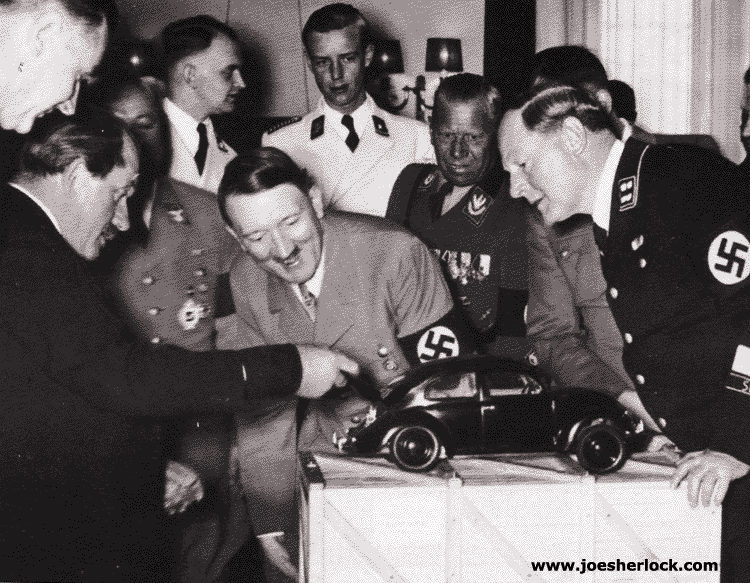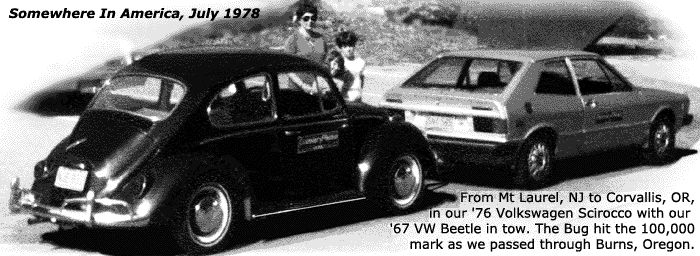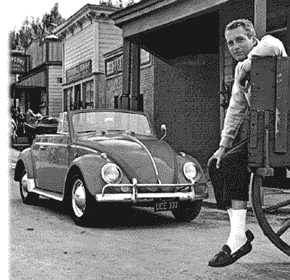Out Of Air: A long chapter in the history of Volkswagen has ended - the last air-cooled motor was hoisted into a VW Microbus in San Paulo, Brazil in December 2005. The move comes three years after Volkswagen's Mexican division stopped production of the minivan, and churned out its last two-door bug sedan with an air-cooled motor. Over the years the little flat-four motor was installed in over 26 million vehicles - 20 million Beetles and 6 million buses and vans.
The Volkswagen story is so ridiculous that it sounds like the script for a Mel Brooks movie:
Adolph Hitler orders a car for the German masses. The Nazi high command has it designed and prototyped. Hitler calls it the Peoples' Car. Only a few examples are made before World War II begins. Germany loses the war. The tooling for the car is offered to Henry Ford II who laughs and turns it down, believing the car has no commercial future. Germans begin to assemble the car in the ruins of a bombed-out factory.

The factory manager hires a Dutchman who knows little English to introduce the car to America. By that time, the design is now over 10 years old. The car looks strange and ugly by modern postwar standards. It is underpowered. It doesn't even have a gas gauge. It has lots of other little quirks including an ineffective heater. They don't even change the name - it's still called the Peoples' Car. America falls in love with it anyway. It eventually breaks the long-standing sales record for a single model held by the legendary Ford Model T.

For several years, there's a three-month waiting list to buy the little German car. The strange design remains basically unchanged for over 30 more years. Many of the quirks are still there 30 years later. People love the car anyway.
Last week, my wife and I were driving in the Pacific Northwest's dark and rainy winter weather and we spotted a vintage VW Beetle just ahead of us. Beetles of one sort or another had been in our family from 1961 until 1995. They were remarkable cars, especially when one considers that their design dated from the mid-1930s.
 We began talking about how miserable VWs were to drive on a wet winter day. The heater was abysmal, especially the pre-1965 models which had a little spigot on the floor to 'pour on' the heat. Warm air trickled forth in miniscule, individual BTU drips - unless you were driving at 70 mph (the heater had no fan - engine rpm provided the oomph). I always kept a rag next to the heat spigot in my '63 Bug, so I could wipe the condensation off windshield every few minutes.
We began talking about how miserable VWs were to drive on a wet winter day. The heater was abysmal, especially the pre-1965 models which had a little spigot on the floor to 'pour on' the heat. Warm air trickled forth in miniscule, individual BTU drips - unless you were driving at 70 mph (the heater had no fan - engine rpm provided the oomph). I always kept a rag next to the heat spigot in my '63 Bug, so I could wipe the condensation off windshield every few minutes.
The defroster was as bad as the heater - the German word for 'defroster' must be Das Emphysema. If any car needed heated seats it was the air-cooled Bug. The factory 'leatherette' could suck all the heat out of buttocks from 3 km. away.
Beetles were wonderful cars in their own way, but, as these vehicles have passed into Legend Status, myths began to envelop and obscure reality. In the '60s, VW was held up as a the pinnacle of quality. But the reality was a little different.
Consider this: If Ford Motor Company had focused on making nothing but the '40 Ford (in two models only, a sedan and convertible) and made only minor changes to it until 1967, I submit that, by the late-1950s, your newly purchased 1940 Ford would have been The Best-Built Car You've Ever Owned.
Give manufacturing engineers 15-plus years to get the squeaks, rattles and niggling little defects out of that '40 and provide them with the same timeline to tweak stamping dies and various assembly jigs to get the fit and finish 'yust zo', and the ancient Ford would have been far superior to even a Rolls Royce.

One of the reasons that new VW offerings - the Fastback, Squareback, the atrocious 411/412 and the Golf/Rabbit, Scirocco, etc. - had so many quality issues was because VW had no idea of how to debug (no pun intended) a new model on the fly. The company only knew how to accomplish it over a 20 year period. Flaws in the Beetle took forever to correct. Detroit changed over to 12 volt electrical systems in 1955. The VW remained on a six-volt system until 12 years later.
The pre-1967 Beetle's glass-covered headlights had the most complex and maddening attachment system ever seen. Tom McCahill once wrote that if a German had created the Mona Lisa, he would have painted on a mustache just for complexity's sake.
Even in the 1960s, red factory taillights sometimes faded due to bad colorant in the plastic, a problem Detroit had solved 15 years previously.
|
|
| This photo was taken in the summer of 1995, just before I sold our Volkswagen to a collector. I had purchased this car new in March 1967. |
|
|
New VWs had an unearthly industrial-plasticizer-mixed-with-mustard aroma that was surely carcinogenic to anyone who was not part of the Aryan Super Race. It took Wolfsburg almost 30 years to put decent sound deadening in the Beetle; owners like me had already DYI'd it on our vehicles.
 The four-speed manual transmission was always noisy, unless you added some molybdenum compound. To me, that indicated that the gears needed a smoother surface finish.
The four-speed manual transmission was always noisy, unless you added some molybdenum compound. To me, that indicated that the gears needed a smoother surface finish.
Engines lasted a long time - if you didn't rev them too enthusiastically and religiously adjusted the valves every 3,000 miles. American cars didn't need such pampering - they had hydraulic lifters and/or self-adjusting valves. VWs had no oil filters; oil had to be changed with alarming frequency.
To be fair, VWs had thick, smooth paint jobs - better than anything Detroit offered. But all except the earth-tone colors faded faster than the paint on domestic automotive counterparts. The Application of Polishing Compound became an annual ritual in our garage.
In the car's heyday, VW Beetles were owned by the rich and famous including Britain's Princess Margaret, aviator Charles Lindbergh, baby expert Dr. Benjamin Spock, The Beatles' John Lennon and actor Paul Newman, who owned four of them over the years. One of his was a red 1963 convertible with a Porsche engine.
No discussion about VWs is complete without a word about the Microbus. The Beetle was slow - the 40 horsepower model took about 21 seconds to reach 60 mph at full throttle. The Microbus wouldn't even reach 60 mph without a substantial tailwind. Microbus owners were patient people who liked to savor the pleasure of looking around at all of Nature's wonders as they chugged their way through life. So they drove using light throttle pressure, causing the Microbus to accelerate like a glacier.
Today, these same people have traded up to modern VW-badged, box-like offerings but still drive them just like a '62 split window bus, perhaps for nostalgic purposes.
Look at any long line of traffic and the lead vehicle will be one of the following:
1. A #$%&* school bus
2. A geezer with handicapped plates
3. A 92 year-old Hans Moleman clone driving a large motor home
4. A VW bus
It's true. Check it for yourself.(posted 1/2/06)

